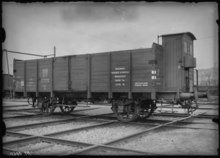Brake truck
As sled be railway carriages which, at the purpose of increasing the braking force in a train are queued. As a rule, this is not a special type of car, but a pure functional description.
The accompanying cars , which are no longer so widespread today, also performed the function of a brake car , especially before the introduction of the pneumatic brake. A typical example of an escort car that also acts as a brake car are the caboose lined up at the end of the train on American railways .
reasons
Brake cars are used where the braking power of the locomotive (s) and the braked car does not reach the required ratio of total weight and braked weight ( braking hundredths ) in order to be able to carry out a scheduled journey at the intended speed. This was especially the case in the freight train area on steep routes . In particular, before the widespread use of continuous air brakes , not all cars were braked here. Cars with brakemans were often added to the trains as brake cars. In some cases, brake trucks are also used in traffic with unbraked trolleys .
Even today, the transfer of vehicles with a defective or missing brake system of the compressed air brake still requires the use of brake trucks, especially if several such defective vehicles are to be transferred in the same train. In this case, a group of damaged and brake vehicles is often formed so that the required braking percentages can be adhered to on the routes to be traveled . In this case, any wagon that can be used in accordance with the rules and has a functioning automatic brake can be used as a brake wagon (empty freight wagons are usually used).
The use of brake trucks can also become unavoidable when transporting unusual shipments . If the load is significantly heavier than the braking capacity of the wagon on which it is loaded, this wagon alone may no longer be able to meet the minimum braking percentage required. In this case, before and after the wagon with the exceptional shipment, brake vans with fully chargeable brakes must be lined up.
Car with brakes
Before the introduction of the pneumatic brake, modified cars with brakes were used in the German railways . As a rule, it was a matter of normal freight or passenger wagons, which differed from normal wagons only by brakes and often by a brakeman's cab . As such, these wagons are not referred to as brake vehicles, as their primary function is to transport freight, but the secondary function corresponds to that of a brake vehicle.
Individual evidence
- ↑ a b Encyclopedia of Railways: "Brake Car"
